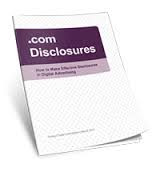The Federal Trade Commission issued the original Dot Com Disclosures in May 2000 in response to a rising discussion about how FTC rules
and guidelines apply to online advertising.
These were developed as a guide to let advertisers know how to make
effective disclosures in digital advertising. An updated version of the Dot Com Disclosures was released in March 2013 to better reflect the amount of
advertising that is now being done on social media platforms, mobile devices
and other “space-constrained screens”.
While one can spend hours reading and going through the
examples, there are really three things advertisers need to keep in mind when
trying to figure out how to apply these to their ads.
1. Deception
is Unlawful No Matter What
 The FTC originally developed consumer protection laws to protect consumers and prevent false communication. They wanted to ensure consumers have
clear and accurate information about things they pay for and, as a result, maintain a high level of confidence in the marketplace. This has not
changed with the evolution of the Internet and increase in new mediums
available to reach consumers.
The FTC originally developed consumer protection laws to protect consumers and prevent false communication. They wanted to ensure consumers have
clear and accurate information about things they pay for and, as a result, maintain a high level of confidence in the marketplace. This has not
changed with the evolution of the Internet and increase in new mediums
available to reach consumers.
In short, the same laws and principles that apply to traditional
forms of advertising extend to digital advertising. While advertising may now
be taking place through new mediums such as smartphones, tablets and social platforms, the rules are still the same. Advertisements must be clear and conspicuous and ads without disclosures could be considered deceptive and unfair.
2. “Clear
and Conspicuous” is in the Eye of the Consumer
The Dot Com Disclosures do not provide a formula for creating
compliant ads and they can’t let you know if you will be liable for running a specific
ad. According to the Dot Com Disclosures, all advertisements must me “clear and
conspicuous” and that is determined based on how the ads perform with the
consumers. If you think an ad is clear and customers complain that it is not .
. . well, it isn’t clear enough.
The Dot Com Disclosures include guidelines as to where to place
disclosures so that they are visible enough and what kinds of things need to be disclosed. They also give recommendations as to how to deal best
deal with space crunches and changes in formatting. For example, they talk
about using hyperlinks to link to disclosures and making the buying platforms and websites compatible with mobile devices so
that disclosures won’t be missed. However, in most situations there is more
than one way to properly format an ad. The best way is the one that most
effectively communicates the information to the consumers.
3. Use
Common Sense When Creating Ads
The great thing about ads and buying platforms is that they are
often created by the same kinds of people who use them. By looking at
the advertisement from a consumers point of view and asking a few simple questions, one can get
a pretty good idea as to whether or not the ad could be misleading.
 |
Medifast fined for making
unsupported Claims |
Are the disclosures present and in
proximity to the claim?
If
not, move them so that they are to ensure they won’t be missed by potential
customers. If a customer has to scroll down to the bottom of the screen to find the disclosures, or if they misinterpret what they are guaranteed they could feel mislead.
Are all charges accounted for before the end of the purchase funnel?
This
includes things such as taxes, extra fees, term lengths, recurring charges, shipping, etc. and it all needs to be presented in
a visible manner and broken down clearly before the consumer clicks “I Do”. If the customer gets billed for extra charges they are not aware of, it could result in fines for unclear advertising.
Are you able to
disclose the necessary information?
If
not, don’t run the Ad.
Also Note:
The Federal
Trade Commission’s rules apply to advertising in the United States. When marketing to another
country, know that they may have similar types of guidelines and you need to
check their laws to know if your ad is compliant. If you are in another country
marketing to the US, read these rules to make sure you are properly disclosing
the necessary info and that your ad is compliant.
















